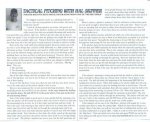- May 30, 2010
- 12
- 0
What if you only had 3 pitching mechanics to teach, what 3 would you choose?
SLUGGERS: This is a real interesting question...so, I've hijacked it. Anyway, what are the three most important parts of the pitching motion? Don't cheat--Rotation123 asked for THREE (not 4 or 5). Thanks...Ray
SLUGGERS: This is a real interesting question...so, I've hijacked it. Anyway, what are the three most important parts of the pitching motion? Don't cheat--Rotation123 asked for THREE (not 4 or 5). Thanks...Ray
Last edited by a moderator:




